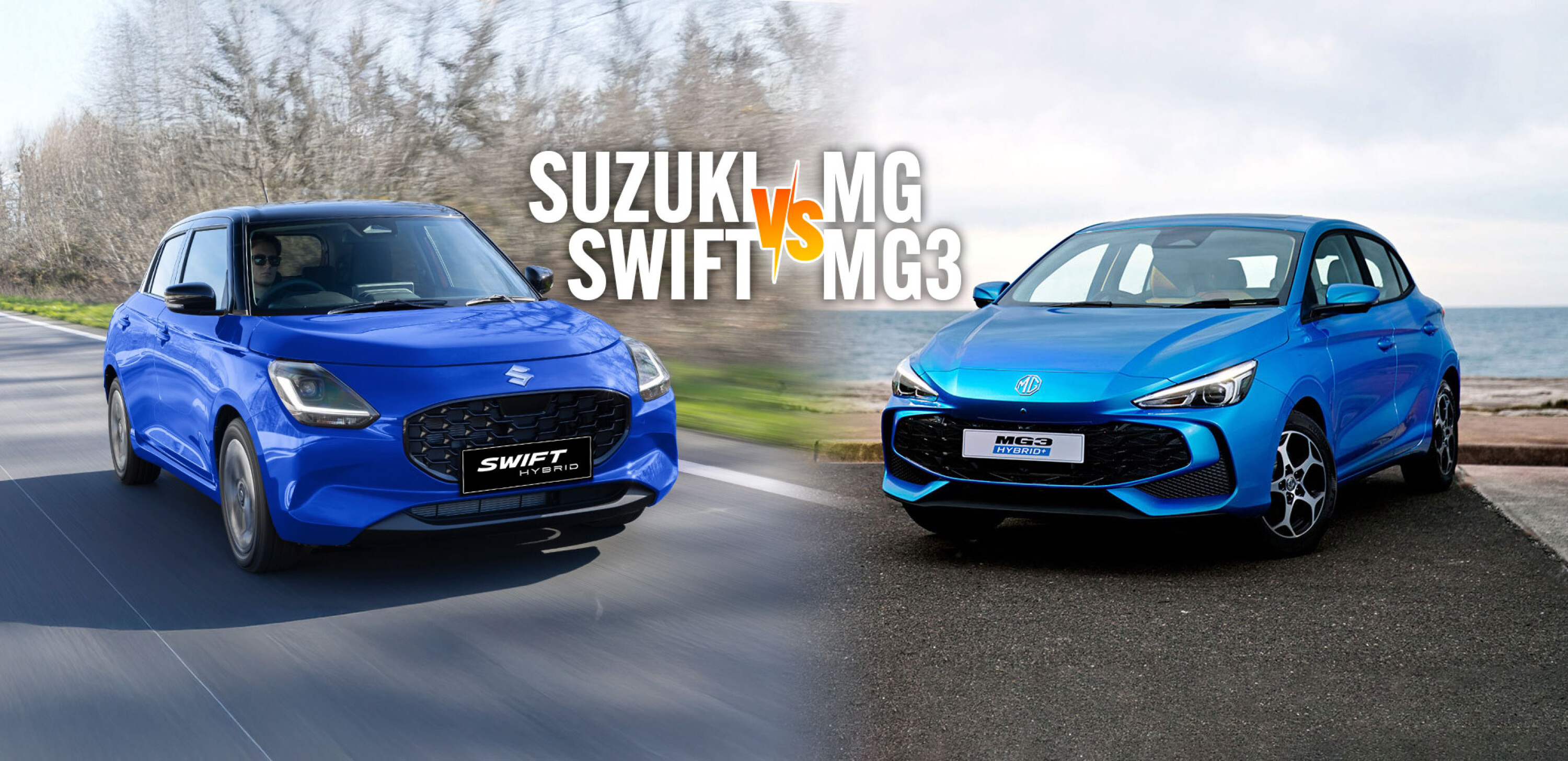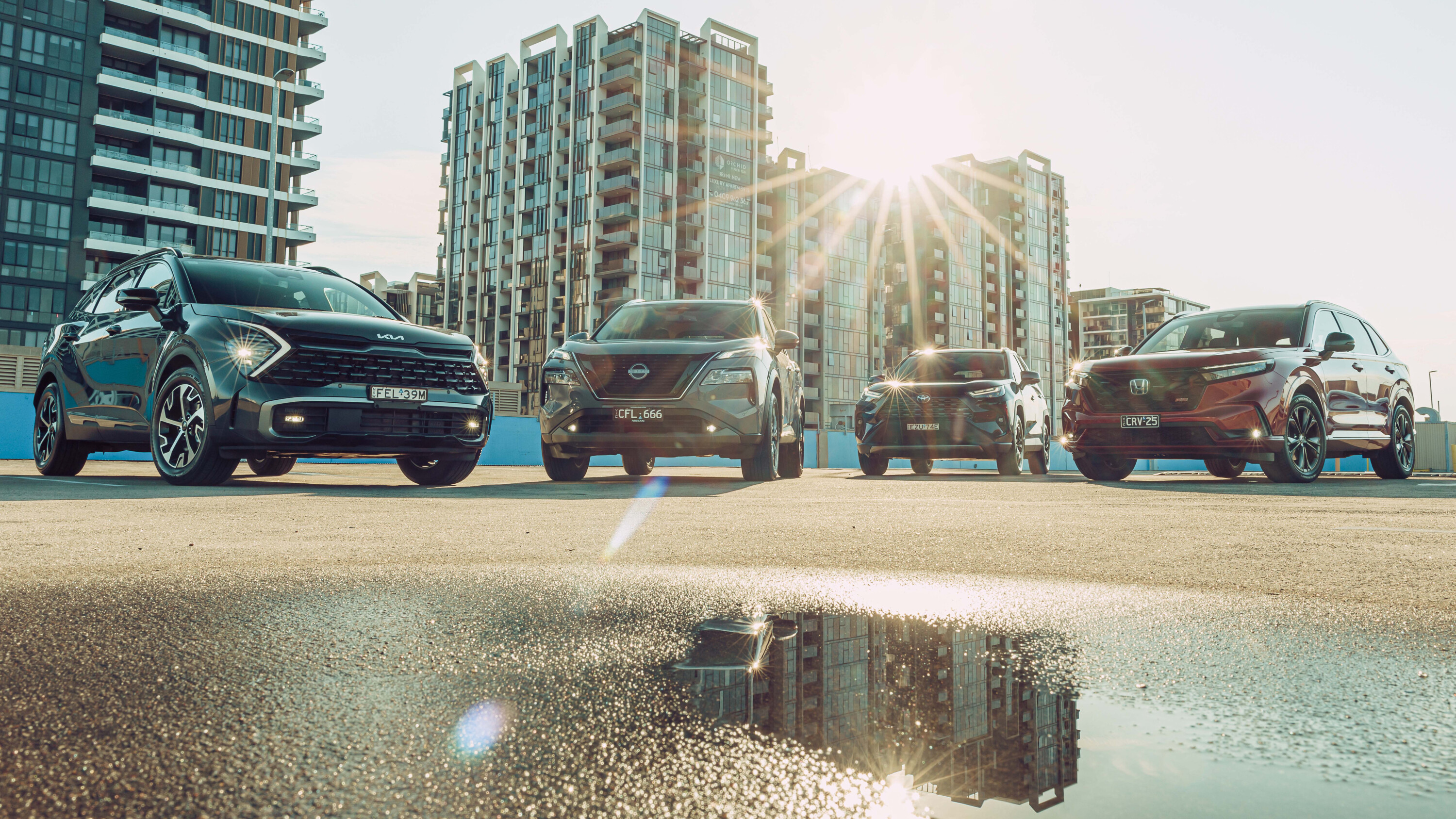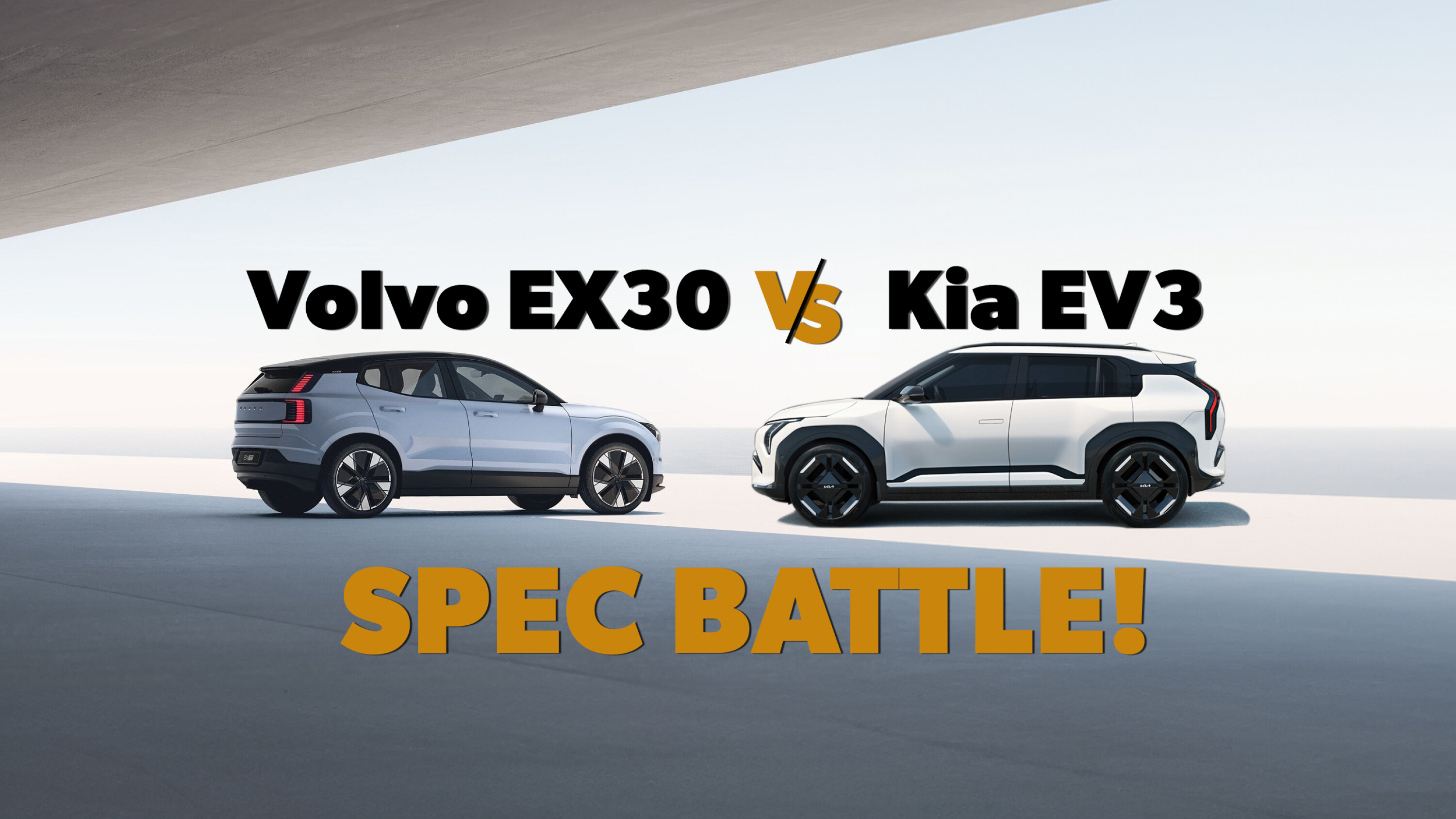
If you’re looking to put an electric car in your driveway and you’re not too shy on the cost, these are the EVs sold in Australia with big power, a long driving range and, in most cases, room for the family.
This guide is intended to serve as an outline of each model available in that critical $65,000 category, to help you decide which models you’d like to know more about. With each model listed below, you’ll find links to our more comprehensive deep-dive reviews of each car.
Welcome to our EV Buyer’s Guide: Electric Vehicles priced from $65,000 to $80,000 – The Best and The Rest
Sweden and Korea dominate the middle group of our EVs Under $100K Megatest, with a pair apiece.
Scandinavia serves up the Volvo XC40 Recharge, the fully electric version of a compact SUV that won 2019 Wheels Car of the Year in petrol form.
That’s joined by its relative, the Polestar 2 sedan from Volvo’s spin-off electric performance brand – which launched locally at the start of 2022.
Although Polestar 2 pricing officially starts from $63,900, a flagship Dual-motor Long Range model was provided for testing. That base model also quickly jumps in cost once options packs are included to add highly desirable features (and a more respectable safety kit).
The Hyundai Ioniq 5 is regarded by many as the most strikingly designed EV yet put into production, and it has proved to offer substance beyond its retro-futuristic sheetmetal – not least with a runners-up spot in our 2022 Wheels Car of the Year. It was pipped to Australia’s ultimate automotive accolade by its twin, the Kia EV6.
Last but certainly not least is another new-for-2022 EV – the Tesla Model Y, the SUV relative of the Model 3 sedan.
If you have a smaller or bigger budget for an electric car, see our other stories in this series here:
NOTE: This story, along with our other price-based EV buying guides (see links below) will be updated over time. You may see the scores and ranking of these models change as they age and as more compelling rivals enter the market. |
JUMP AHEAD
- BEST BUY: Kia EV6 Air
- $72,590 + on-road costs
- Large SUV, 5 seats
- Single-motor RWD, 77.4kWh battery
- 528km range, 350kW fast charge
- Highly recommended: Tesla Model Y
- $68,900 + on-road costs
- Medium SUV, 5 seats
- Single-motor RWD, 60kWh battery
- 455km range, 210kW fast charge
- Highly recommended: Hyundai Ioniq 5 Dynamiq
- $69,900 + on-road costs
- Large SUV, 5 seats
- Single-motor RWD, 72.6kWh battery
- 481km range
- Polestar 2 Long Range
- $69,900 + on-road costs
- Small sedan, 5 seats
- AWD dual motor, 78kWh battery
- 480km range, 150kW fast charge
- Volvo XC40 Recharge
- $79,490 + on-road costs
- Small SUV, 5 seats
- Dual-motor AWD, 75kWh battery
- 450km range, 130kW fast charge
- VERDICT ?
- COMING SOON: Charging and driving range tested ?

Kia EV6 Air
The Kia EV6 is the brand’s first dedicated electric vehicle and its top-spec GT-Line AWD variant was the winner of Wheels Car of the Year in 2022.
But with that bar set so high, how does its lesser EV6 Air RWD sibling fare?
| THINGS WE LIKE | NOT SO MUCH |
|---|---|
| Exceptional ride and handling | Missing features |
| Performance even from base-spec RWD | Rear row comfort |
| Swoopy good looks | Price no longer able to access EV incentives |
Pricing for the base-spec Air starts from $72,590 plus on-road costs, which unfortunately means it does not qualify for any current state-based EV incentives.
As standard, the EV6 Air gets features such as; three USB ports (one type A and two type C) in the front, plus two USB Cs for rear occupants, a wireless phone charger and a six-speaker sound system. It also has 19-inch machined alloy wheels.
What the Air sadly misses out on are features such as; a vehicle-to-load exterior adaptor, a head-up display, eight-way electrically adjustable seats, and a powered tailgate.
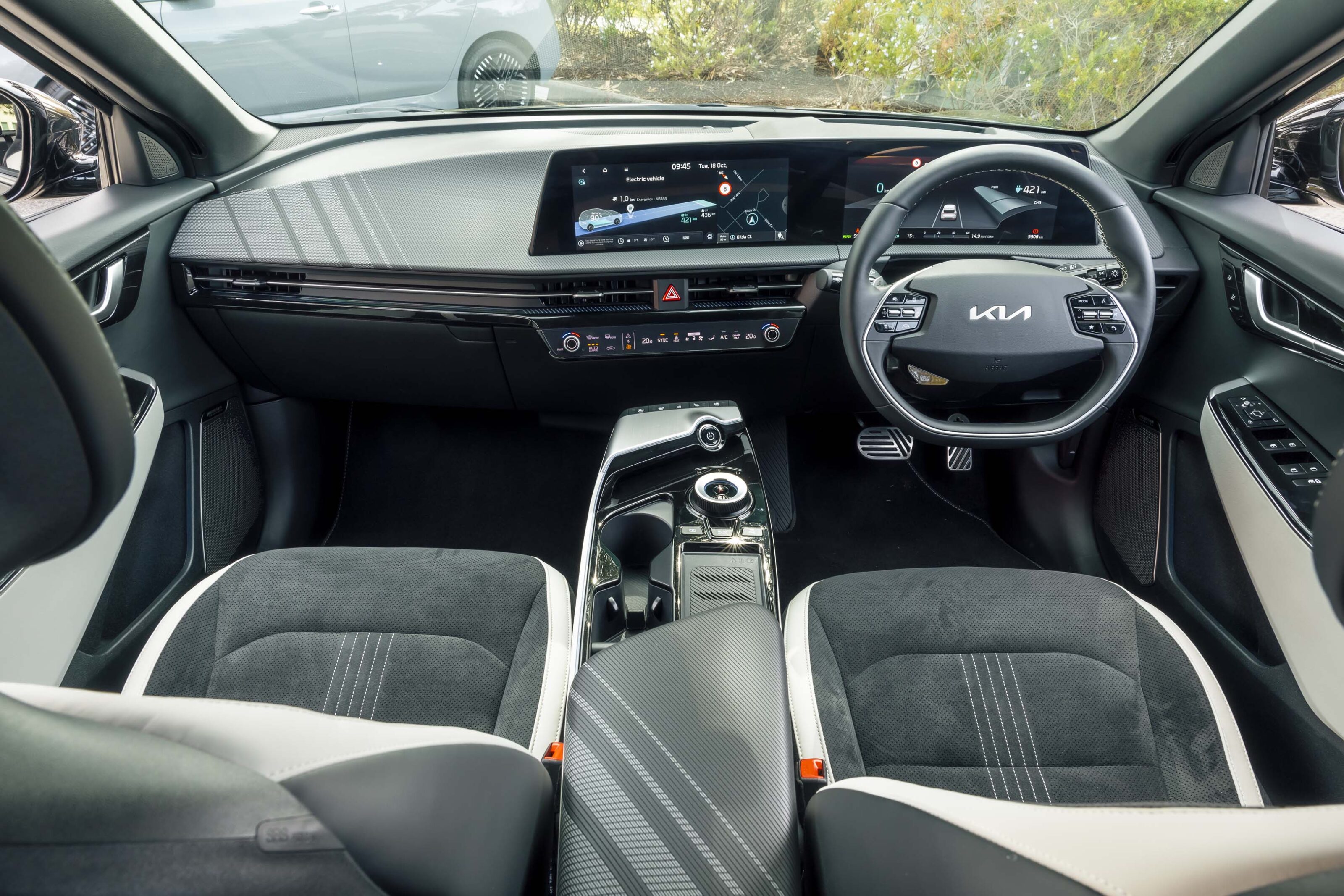
The 12.3- plus 12.3-inch combined infotainment screen and digital instrument cluster set up found throughout Kia’s updated model range looks modern and borderline-futuristic in its appearance. It’s clean, easy to use and doesn’t try to be too over the top or clever, while still offering plenty of tweak-able options.
The Air’s black interior with light grey cloth headliner distinguishes it from its GT-Line counterparts and the cabin remains a neat, modern and inviting environment.
While its flush door handles add to the visual appeal and no doubt help with the aerodynamic gains, they unfortunately – from a practical family point of view – make trying to get them open while also trying to juggle a million other things in your hands nigh-on impossible.
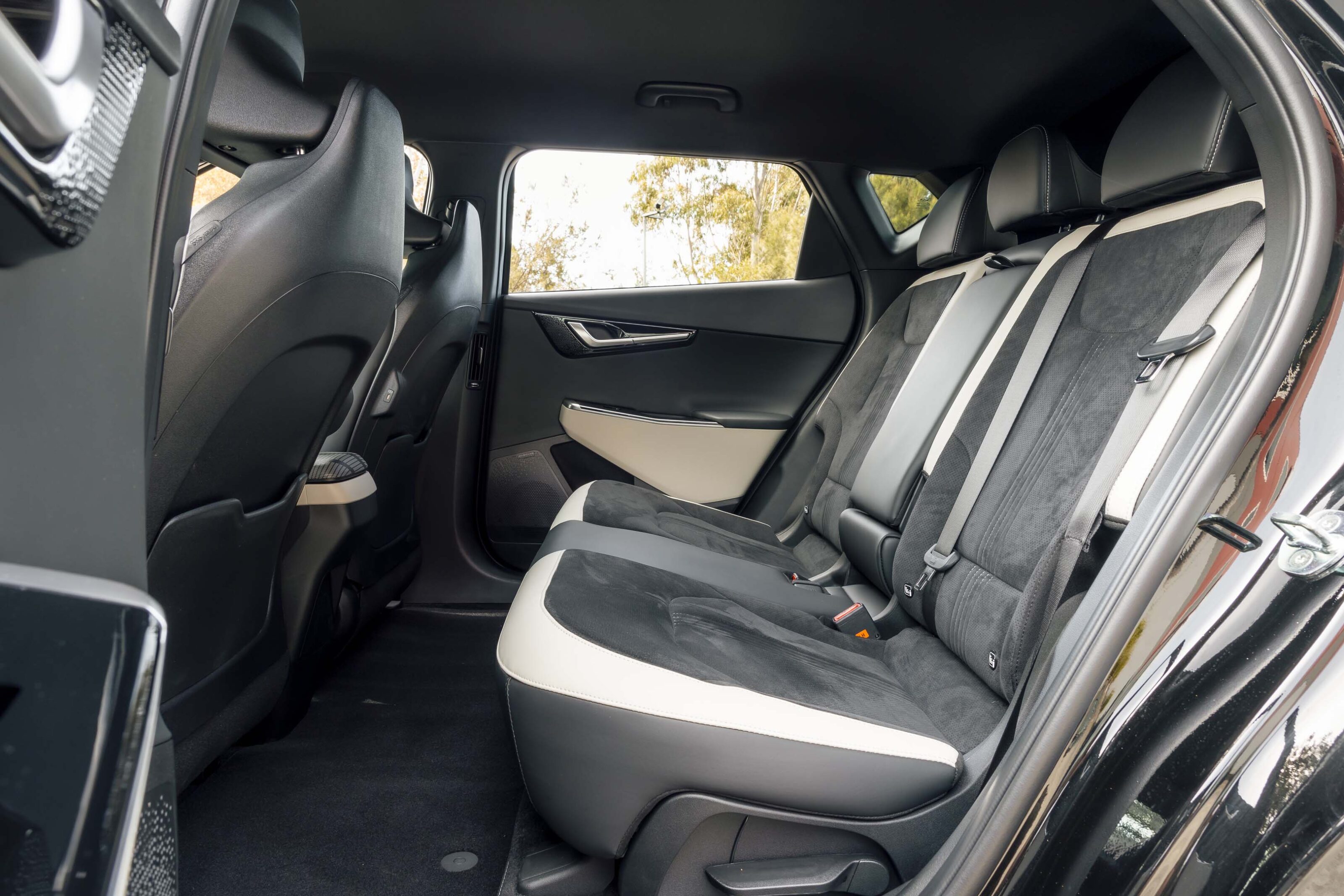
The EV6 was awarded a five-star ANCAP safety rating in 2022, and as standard benefits from safety features such as; lane keep assist, blind-sport collision warning and avoidance assist (with rear cross traffic too), and parking sensors front and rear.
In addition to lacking some modern creature comforts like heated seats and a powered tailgate, the Air variant is also bettered by the GT-Line in one quite important way – comfort.
The manual adjustment coupled with the cloth and artificial leather combo for the seats makes them harder than is desirable. Moreover, the back row is a little disappointing when it comes to comfort too. It cannot comfortably fit two adults plus a child’s car seat for more than a short journey. Legroom too suits only average-sized occupants.
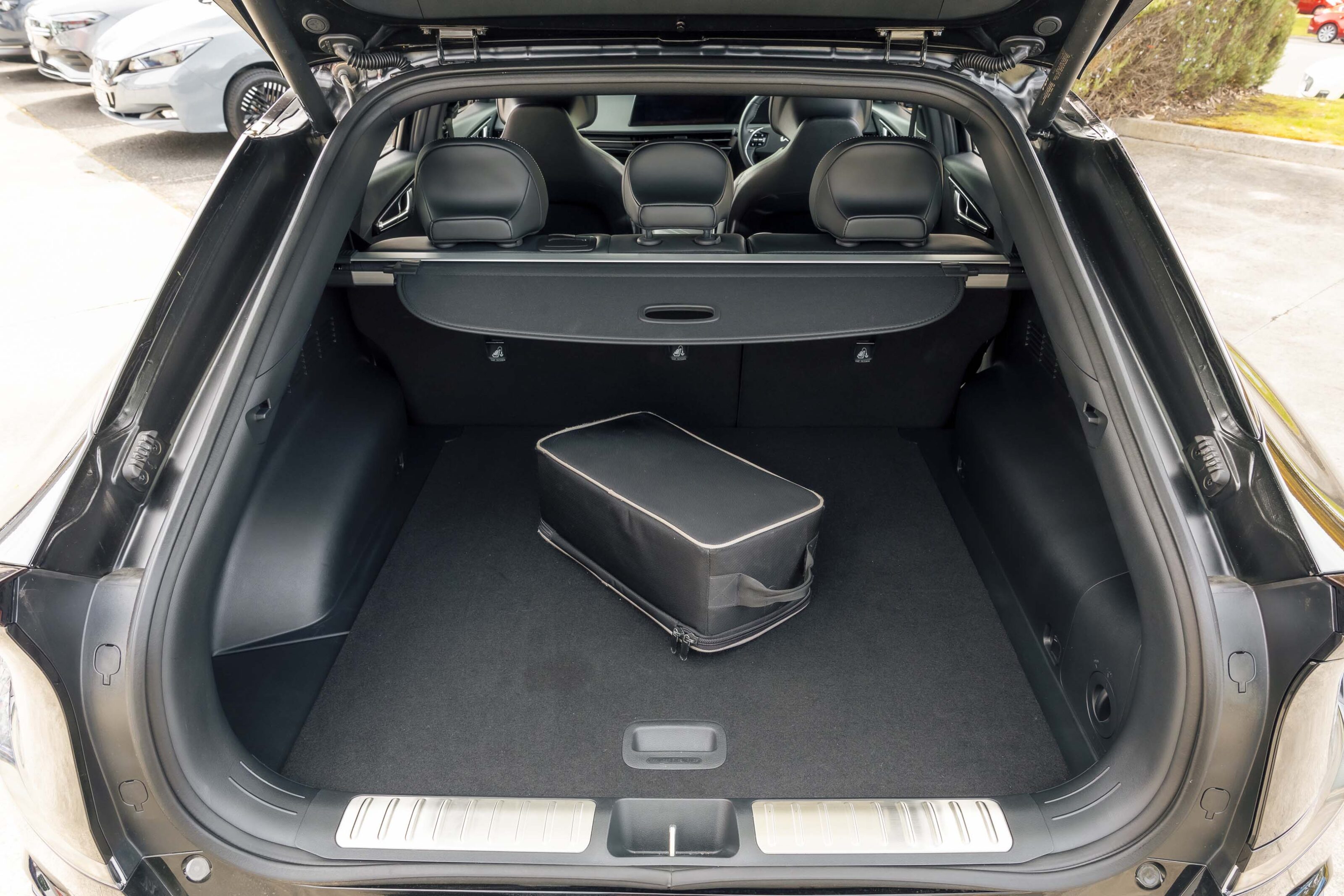
Storage in the EV6 is, however, capacious up front, where there are multiple areas to keep things – there are nooks in both doors for smaller items, a central cubby bin which is surprisingly deep, and a cavernous cradle underneath the floating centre console.
Having been tuned in Australia through the marque’s new local ride and handling program, the EV6 is well matched to our roads. The steering is well-balanced, neither too light nor too heavy. It’s controlled around corners and roundabouts, and gives the driver a confidence that the vehicle is well placed and weighted on the road.
The EV6’s low centre of gravity makes it feel more sports car than SUV, and thanks to a composed suspension it glides over uneven road surfaces with little fuss.
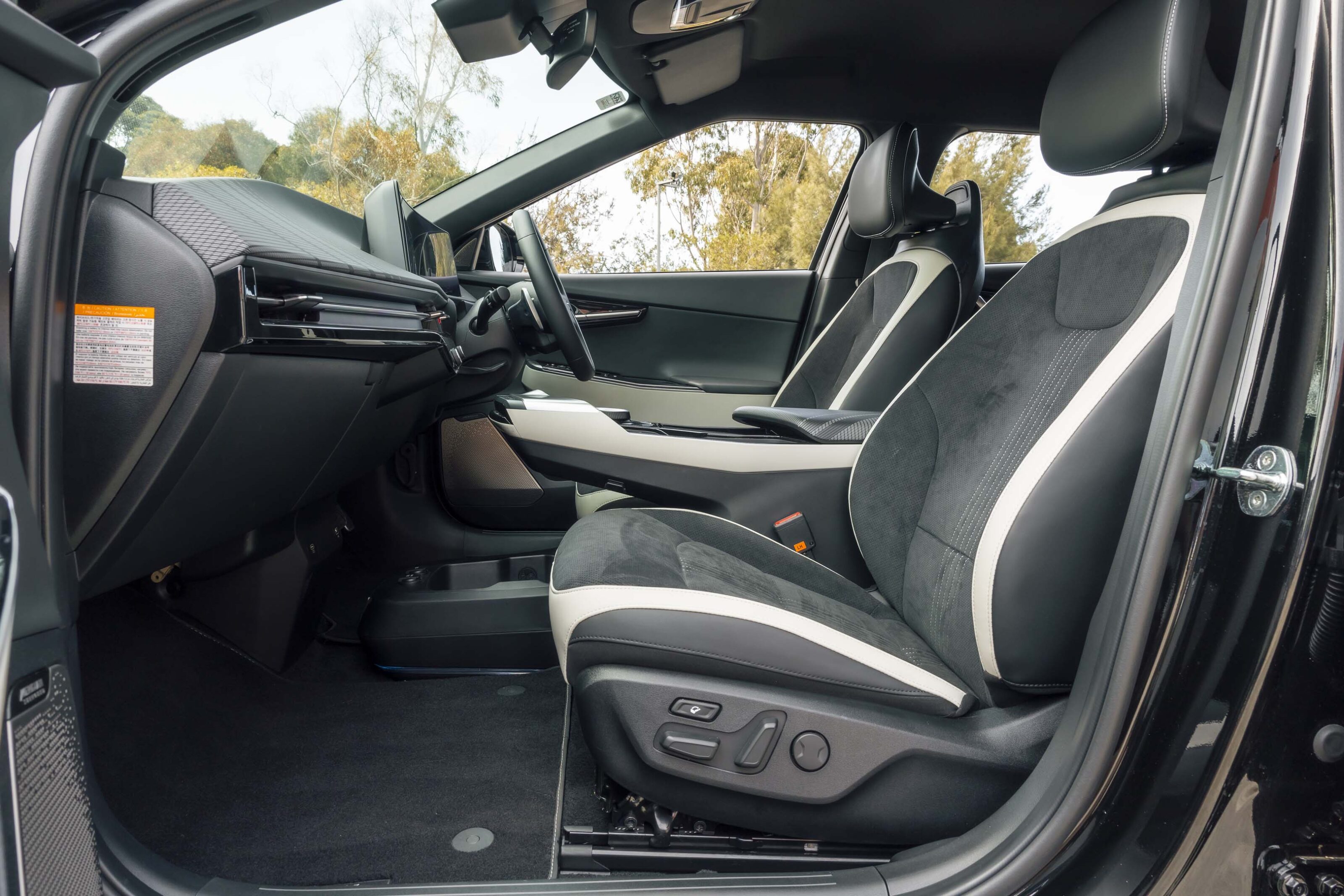
A claimed 528-kilometre driving range comes courtesy of a 77.4kWh battery, and the EV6 is capable of using a type 2 350kW DC fast charger to go from 10 to 80 per cent in 18 minutes, or a 50kW DC fast charger in 73 minutes.
Kia Australia offers a seven-year/unlimited kilometre warranty, with a seven-year/150,000km battery protection and capped-price servicing. Servicing for the first year is $129 or a pre-paid service plan for the first three years is $594.
Kia has really outdone itself with the EV6, creating an exciting, capable and good-looking machine – compelling enough to entice petrol or diesel vehicle owners over to electric.
Where the Air variant falls down is on nice-to-have features, such as heated and electrically-adjusted seats and a powered tailgate, which are commonplace nowadays even on much cheaper cars.
SCORING: Kia EV6 Air
| OVERALL | 8.5 |
|---|---|
| Safety, value and features | 8 |
| Comfort and space | 7.5 |
| Engine and gearbox | 9 |
| Ride and handling | 9 |
| Technology | 9 |
Specifications

Tesla Model Y
The Model Y offers all the benefits of Tesla ownership, wrapped up in its most practical package yet.
| THINGS WE LIKE | NOT SO MUCH |
|---|---|
| Ultra spacious cabin | Dizzying array of menus |
| Genuinely competent to drive | Concedes efficiency to Model 3 |
| Stowage space | Increasingly good rivals at this price |
| Supercharger network access |
Some note title here
It’s worth noting here that the Tesla Model 3 Long Range, priced from $76,900 (at the time of writing), deserves a spot on this list just as well as the Model Y. While it’s likely we’ll add it here in the near future, you can read all of our comprehensive Model 3 reviews here in the meantime: Tesla Model 3 news & reviews
Tesla’s long-awaited Model Y finally arrived locally in 2022, launching the entry-level rear-drive Standard Range from $72,300 (before on-road costs), or $6800 more than the entry-level Model 3.
Now, only a few months later, the Model Y has been reduced to an entry price of $68,900, marking a not insignificant improvement in its accessibility for Aussie motorists keen to move into the EV space.
The Californian-designed and Chinese-built Model Y and Model 3 siblings share around 75 per cent of their components, and you can see it in the light assemblies, door handles, mirrors, switchgear – everywhere. It’s a remarkable feat of efficiency, and one that seems inline with Tesla’s minimalist brand identity.

The Model Y measures nearly six centimetres longer than the Model 3 sedan, at 4.75m, and is seven centimetres wider. The wheelbase is 1.5cm longer while the roofline, at its highest, measures 18cm taller than the smaller Model 3.
This all lends to an interior that, in particular for an already pared back Tesla cabin, feels tremendously airy and open. There’s an old joke about Tesla cabins looking like a Scandinavian lounge room, but in the Model Y… it really does.
The lack of buttons and switchgear, however, means that all of those controls need to go somewhere, and they’ve gone into the screen. It’s no secret that Tesla’s stubborn controls and interfaces can be frustrating to familiarise yourself with, but through the lens of long-term ownership, many of these initially dizzying differences will be ‘set and forget’ for most buyers.

Front occupants gain an extra 1.7cm of headroom over the Model Y’s sedan-bodied sibling, while rear occupants benefit from an almost 4.5cm increase.
Standard kit includes 19-inch wheels, a 13-speaker premium audio system, electric front seats, heated front and rear seats, heated steering wheel and a full-length glass sunroof.
Safety features include blind-spot detection, lane-departure warning and forward collision assist. There is also a $5100 optionable Enhanced Autopilot package that adds auto lane-changing, auto overtaking, self parking functions and a comprehensive freeway adaptive cruise system.
Just like the minimal cabin further up, the boot is similarly capacious, measuring 854L to the roof (and including the deep underfloor storage bin), up a whopping 52 per cent over the Model 3’s 561L. Two release switches allow the rear seats to be folded from the rear, signalling real world liveability considerations from the tech-turned-carmaker. There’s also a further 117L of under bonnet storage up front.

Being a bigger vehicle, the Model Y does concede some performance to the smaller Model 3, taking 0.8 seconds longer to complete the 0-100km/h sprint (Tesla claims 6.9sec).
WLTP driving range is rated at 455km. Over our 200km range test, the Model Y consumed 34.0kWh of energy for a tested consumption of 17.1kWh/100km and 335km real-world driving range.
It took 45 minutes to recuperate those 34.0kWh of energy, returning an average charge rate of 45.3kWh, placing it behind both Mercedes’, the BMW i4, Kia EV6 and Hyundai Ioniq 5. These results are a little unexpected. Blame being a bigger vehicle and long stretches of highway on our test route, but perhaps we can blame a slow public charger for unexpected charging rates.

Elsewhere, the Model Y is a fine car to drive, with powerful standing acceleration, surprisingly sharp steering and good body control.
What’s interesting about Tesla is how much everything outside of the actual vehicle comes relevant to prospective ownership. Picking a Tesla gains you access to its more established supercharger network, and may even get you better parking at the shopping centre – both hugely underrated benefits.
Tesla’s vehicle warranty, however, is a little shorter than some, at four years/80,000km. The Model Y offers all the perks of Tesla product ownership that buyers expect and have grown to love, but offers it in arguably the most functionally appealing packaging yet.
SCORING
| OVERALL | 8.5 |
|---|---|
| Safety, value and features | 8.5 |
| Comfort and space | 9 |
| Engine and gearbox | 8.5 |
| Ride and handling | 8 |
| Technology | 8.5 |
Specifications
| Tesla Model Y | ||
|---|---|---|
| Price | $68,900 + on-road costs | |
| Size & segment | Medium SUV | |
| Seats | 5 | |
| Boot space min/max | 854L / 2158L | |
| Drive | single-motor RWD | |
| Battery size | 60kWh (est.) | |
| Outputs | 220kW / 420 Nm | |
| Efficiency | 17.10kWh/100km | |
| Driving range | Claimed | Tested |
| 455km | 335km | |
| Charging speed | Claimed | Tested |
| DC fast charging | 210kW, 10-80% 27 min | 45.3kWh, 36-100% 45 min |
| AC home charging | 11kW, 10-80% 8hr 15 min | not tested |

Hyundai Ioniq 5 Dynamiq
It was a breakthrough EV for Hyundai last year, but is the edgy Ioniq 5 still at the pointy end of the class in 2022?
| THINGS WE LIKE | NOT SO MUCH |
|---|---|
| Edgy, retro-futuristic design | Ride can feel unsettledu00a0 |
| Cabin majors on wow factor, comfort & storage | Over eager Lane Keep system |
| Rapid charging capability | Huge demand and low supply |
Here’s a challenge: name an EV that turns more heads right now than the Hyundai Ioniq 5. Even if the big Hyundai’s edgy retro styling doesn’t tickle your particular fancy – anyone else see Lancia Delta Integrale in the profile? – there’s no denying it’s a striking thing to look at.
And as we discovered when the Ioniq 5 almost won our 2022 Car of the Year award (it was just edged by its swoopier Korean sibling, the Kia EV6), there’s plenty of substance to back up the strong focus on style. Rapid performance, ultra-fast 350kW charging and a palatial, thoughtfully designed cabin? Hyundai’s breakthrough EV is a compelling package. And at a reasonable price, too…
As is the way of the universe sometimes, though, the Hyundai Ioniq 5 you see here isn’t actually the newest model. Almost to the day that our megatest kicked off, Hyundai announced a sizeable MY23 update that adds a larger battery, more range, more power and – crucially – a revised chassis tune that aims to improve body control and bump absorption.

It has also brought a price rise. The rear-drive Dynamiq variant we’re testing here, for example, jumps from $69,900 to $72,000 – but you do gain an extra 8kW (for a total of 168kW/350Nm) and a larger 77.4kWh battery that boosts the WLTP range by 26km to 507km, so it feels a worthwhile upgrade.
Still, while our test car mightn’t be the latest iteration, all of the bones that make the Ioniq 5 so enticing remain. The exterior is dripping with cool design details (the vertical light strips that ‘bleed’ through the front bumper and the sci-fi blocky taillights are our personal favourites) and inside the Ioniq 5 is incredibly roomy.
It’s built on Hyundai’s bespoke E-GMP platform so you score a completely flat floor and a 3000mm wheelbase that’s actually longer than you get in a seven-seat Hyundai Palisade, so the space inside verges on lounge-like.

The cabin feels light, bright and welcoming and, thanks to a huge digital dash that pairs two 12.0-inch screens, it’s suitably techy and modern, too.
The twin screen layout has a whiff of Mercedes-Benz about it, which is no bad thing, but one area the Hyundai trounces the two Mercedes also in this test is cabin quality. Where the Mercs have thin, squeaky plastics, the Hyundai’s mix of materials feels a cut above. Wasn’t expecting that.
And there’s loads of storage. The cavernous centre console slides fore and aft, the drawer-like glovebox is large enough to fit a laptop, the boot is decent at 527L and because this is the rear-drive model, the ‘frunk’ grows to a useful 57 litres.

You can also recline the front seats almost completely flat and there’s even a leg rest that extends, which makes this the pick of the field if you’re looking to relax while you wait for your EV to charge. Not that recharging takes that long.
The Ioniq 5 is built around an 800-Volt architecture that allows 350kW ultra-rapid charging so you can juice your battery from 10-80 percent in just 18 minutes. And in our charge test, which took the battery all the way to 100 percent, the Ioniq 5 has one of the faster charge rates and went from 59 percent to full in 35 minutes.
The Ioniq 5 isn’t perfect, though. The Lane Keep system is overly intrusive, for example, and while there’s a generous smattering of USB ports (three up front, two in the back) they’re USB-A. That’s old tech now when most cars, including the Kia EV6, offer USB-C. The Hyundai also can’t match the Kia’s seven year warranty and on a twisty section of road, the Kia is a different league.

While it’s sprightly and refined on smooth surfaces (the 0-100km/h claim is 7.4sec) the Ioniq 5’s ride can feel unsettled and niggly over bumps. And on our challenging drive loop, body control was also a touch unruly. Here’s hoping the MY23 suspension tweaks deliver an improvement.
Even in outdated guise, however, the Ioniq 5 was one of the most convincing EVs in this megatest. It’s loaded with personality and its strong focus on design hasn’t been at the expense of how it performs as a roomy and comfortable family car.
The biggest issue is getting your hot little hands on one. Despite holding more than 30,000 expressions of interest, Hyundai has only delivered 758 so far in 2022 due to poor supply. Here’s hoping the taps open up soon…
SCORING
| OVERALL | 8.5 |
|---|---|
| Safety, value and features | 8.5 |
| Comfort and space | 9 |
| Engine and gearbox | 8 |
| Ride and handling | 8.5 |
| Technology | 8.5 |
Specifications
| 2022 Hyundai Ioniq 5 (Tested here but now superseded) | ||
|---|---|---|
| Price | $69,900 + on-road costs | |
| Size & segment | Medium SUV | |
| Seats | 5 | |
| Boot space min/max | 527L / 1587L | |
| Drive | Single-motor RWD | |
| Battery size | 72.6kWh | |
| Outputs | 160kW / 350Nm | |
| Efficiency | 16.5kWh/100km (tested) 16.8kWh/100km (claimed) | |
| Driving range | Claimed | Tested |
| 481km | 449km | |
| Charging speed | Claimed | Tested |
| DC fast charging | 350kW, 10-80% 18 min | 56.2kW/h 59-100% 35 min |
| AC home charging | 22kW, 0-100%, 8 hours | not tested |
| 2023 Hyundai Ioniq 5 | ||
|---|---|---|
| Price | $72,000 + on-road costs | |
| Size & segment | Medium SUV | |
| Seats | 5 | |
| Boot space min/max | 527L / 1587L | |
| Drive | Single-motor RWD | |
| Battery size | 77.4kWh | |
| Outputs | 168kW / 350Nm | |
| Efficiency | 16.5kWh/100km (tested) 16.8kWh/100km (claimed) | |
| Driving range | Claimed | Tested |
| 507km | not tested | |
| Charging speed | Claimed | Tested |
| DC fast charging | 350kW, 10-80% 18 min | not tested |
| AC home charging | 22kW, 0-100%, 8 hours | not tested |
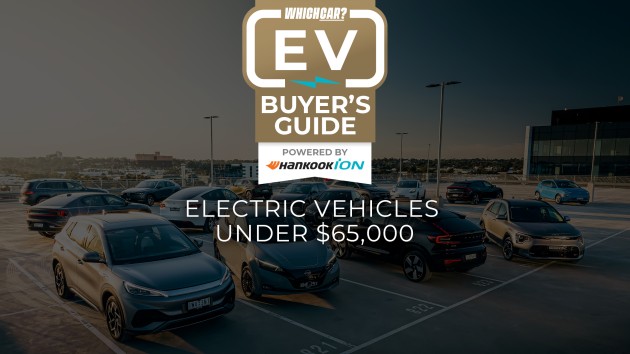
Best Electric Cars Under $65k: Affordable EVs Rated
Welcome to part one of three price-based EV buying guides, this one focused on the most affordable electric cars available in Australia today

Polestar 2 Long Range
Polestar’s first Australian offering brings classic Swedish style and a sharp price but struggles to fast charge
| THINGS WE LIKE | NOT SO MUCH |
|---|---|
| Beautiful design throughout | Slow charging |
| Lovely ride | Pricey options |
| Fun dynamics | Optional safety tech |
If, among its mandarin collared fair trade linen shirts and neutral-coloured sustainable ceramics, Japanese home wares store Muji sold a car, it would almost certainly be the Polestar 2. Its understated but sharp design, beautiful but unpretentious materials and carefully considered functions would sit comfortably on shelves alongside the other minimalist products, as would its representatively affordable price.
The Polestar 2 range opens from $63,900 for the front-drive standard range but here we have the flagship which gets a bigger battery, all-wheel drive and a $73,400 price tag.
For that you get 19-inch alloys, LED headlights, auto wipers, heated front seats, cloth trim with “3D etched” decoration, eight-speaker stereo, a media system that was jointly developed with tech giant Google, front and rear parking sensors, reversing camera, dual-zone climate control, keyless entry and start, and powered tailgate with gesture control.

What you won’t get are a full size spare wheel or even space saver – there’s a tyre repair kit, an artificially generated sound at low speeds, or automatic wipers which seems like a strange omission for such a tech packed and safety focused car.
Speaking of safety, lane-keep assist, forward AEB, lane and road departure warning, driver attention monitoring, road sign recognition are all included.
However, you’ll be asked extra for active cruise control, 360-degree cameras, blind-spot monitoring, front and rear cross-traffic alert, rear collision warning and rear AEB as part of the Pilot pack.
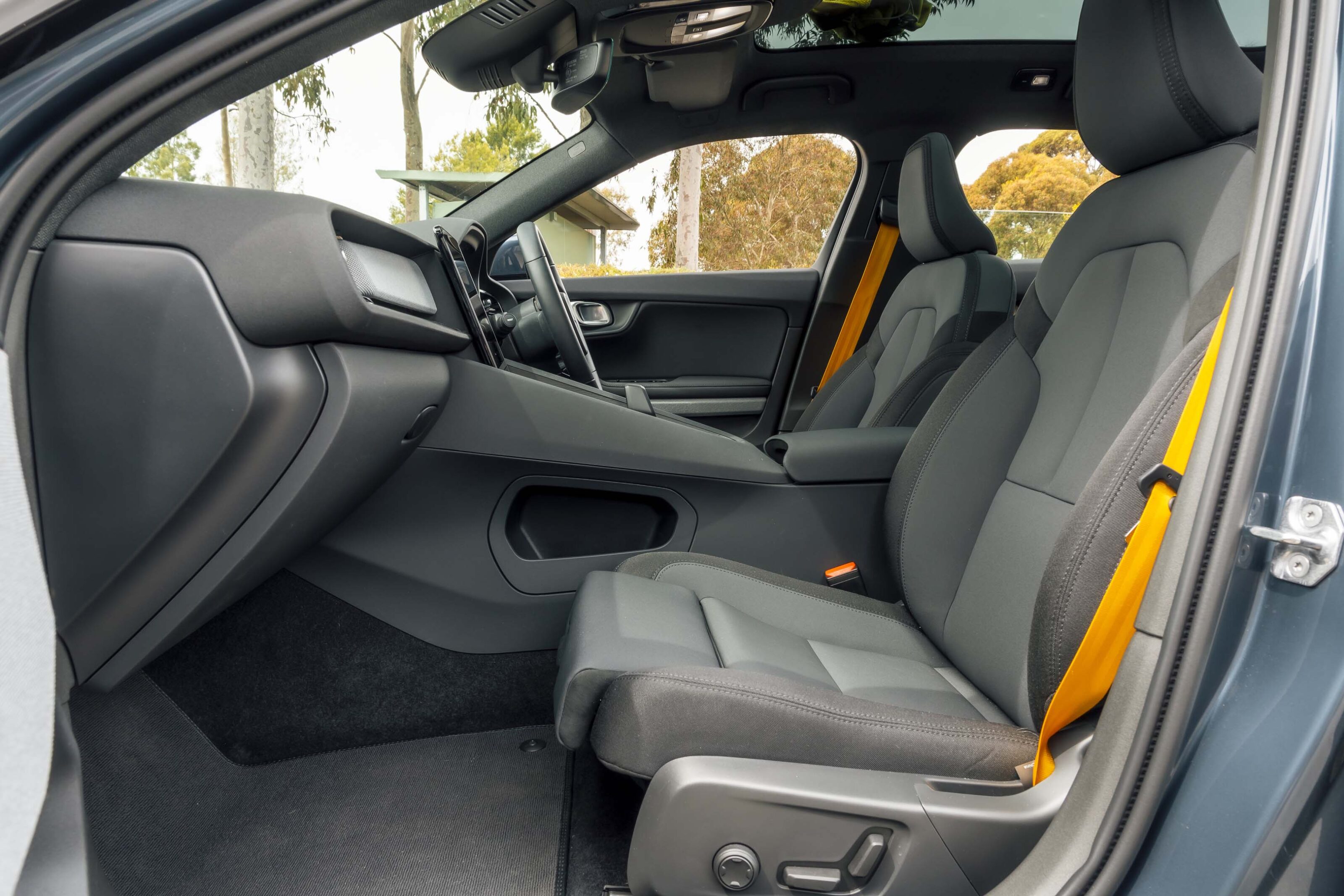
Standard equipment is very well spoken for but it’s the less quantifiable touches that stand the Polestar experience out from the EV crowd. Its vast panoramic sunroof cleverly reflects a hidden Polestar star, the interior is adorned in beautiful materials like the exterior of a high-end Bluetooth speaker, while the keyfob is buttonless and tiny to avoid bulking out your key bunch.
If you’re getting a bit of a Volvo vibe from the Polestar then it’s not your imagination. The Polestar 2 is mechanically very similar to the Volvo XC 40 and C40 Recharge fraternal twins. They’re even offered with the same three variant/drivetrain options.
But as this one has been specced with the most potent Long Range battery and all-wheel drive, it offers the most rewarding driving experience. Acceleration, as you might expect for a car with 300kW and 660Nm with the traction to get it all to the ground, is excellent and Polestar claims the milestone 100km/h is done in 4.7 seconds.
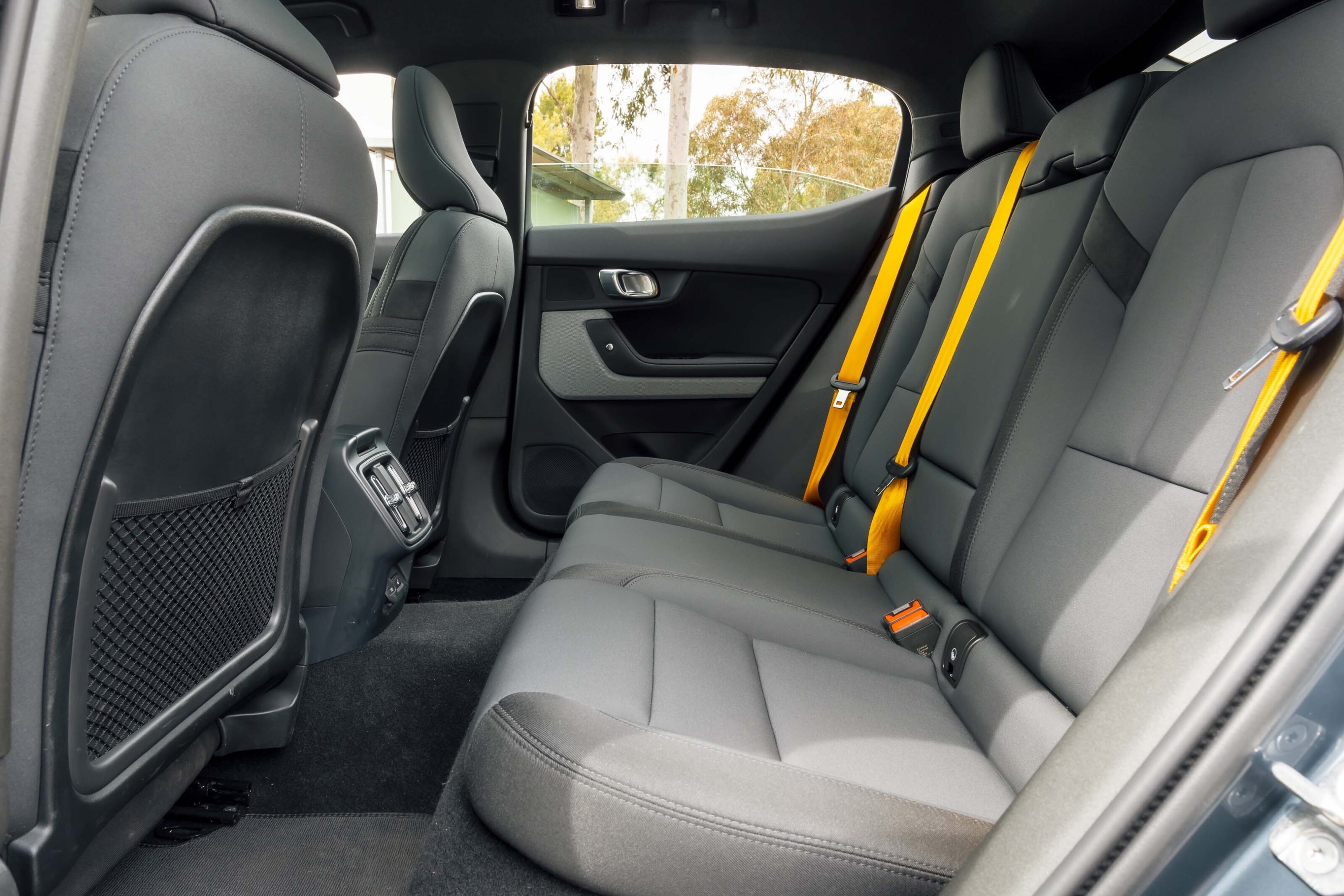
Ours was also treated to the Performance pack which costs $8000 and adds 20-inch wheels, Brembo brakes, those delicious ‘Swedish Gold’ seatbelts and Ohlins dampers. Strangely though, while the latter are adjustable, you have to get the tool box out to do it.
Whatever setting our car had been delivered in was pretty sweet for the conditions and the Polestar 2 has delightful road manners. Body control over horrid surfaces, even when cornering hard, is confident and its steering is precise. Steering weight can be adjusted but the ‘Firm’ setting feels a little false and is best left in the normal state.
The throttle calibration is also deft with an unusual linear progression rather than the more common program that does a majority of the acceleration in the first half of travel with an exponential drop-off in the second portion.
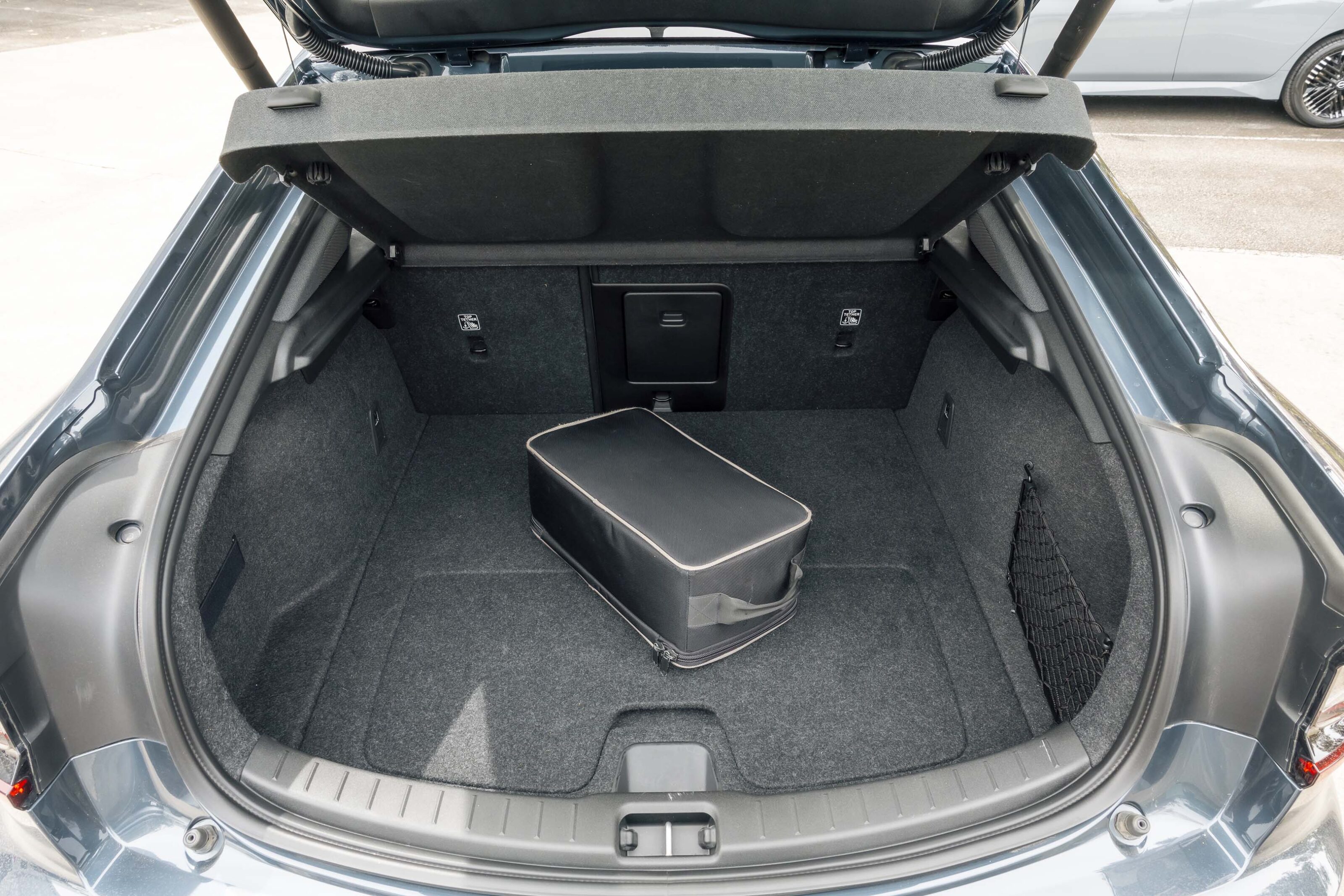
And if you find some loose surfaces, the Polestar is an absolute hoot. With the Continental Sport Contact 6 rubber struggling to deal with damp dirt, the true nature of the playful ESC calibration comes to the surface.
Perhaps the only black mark on the 2’s score card is the difference between claimed and tested charging times. While the Swedish manufacturer claims up to 155kW charging is possible, in practice it took 1.5 hours to fully charge on a public fast charger.
The Polestar 2 doesn’t quite go to the full extent of Muji’s ‘no-brand’ policy, but it certainly does inject the market with competitive quality, performance and design without shouting about it. Polestar’s first Australian offering is the true quiet achiever.
SCORING
| OVERALL | 8.2 |
|---|---|
| Safety, value and features | 8 |
| Comfort and space | 8 |
| Engine and gearbox | 8 |
| Ride and handling | 8.5 |
| Technology | 8.5 |
Specifications
| Price | $73,400 plus on-roads | |
|---|---|---|
| Size & segment | Small SUV | |
| Seats | 5 | |
| Boot space min/max | 405L/1095L | |
| Drive | AWD dual motor | |
| Battery size | 78kWh | |
| Outputs | 300kW / 660Nm | |
| Efficiency | 20.1kWh/100km | |
| Driving range | Claimed | Tested |
| u00a0 | 480km | 368km |
| Charging speed | Claimed | Tested |
| DC fast charging | 155kW, 10-80% 35 min | 26.2kW/h, 51-100% 93 min |
| AC home charging | 11kW, 0-100% 8 hours | not tested |

Volvo XC40 Recharge
The first ever all-electric production Volvo still holds its own with great dynamics, oodles of style, great technology and minimalist interior design.
| THINGS WE LIKE | NOT SO MUCH |
|---|---|
| Regen braking programming | Energy efficiency |
| Minimalist cabin | Jiggly urban ride |
| Sharp handling | Do you need the twin motor? |
The full title is 2022 Volvo XC40 Recharge Twin Pure Electric, but for the sake of word count, we’ll just call it the XC40 electric. It’s available in single- ($72,990) or as-tested twin-motor ($79,490) guise in Australia and an MY23 year model will hit showrooms imminently with minor style and technology updates.
In twin-motor trim 300kW of power and 660Nm of torque are claimed, as is a 0-100km/h sprint of 4.9 seconds. The figures sure feel accurate, if not a little conservative. This is a properly rapid small SUV when you want it to be.
Thankfully though, Volvo hasn’t only worked on pure pace, and the XC40’s drivetrain calibration is right up there with Tesla’s. There are only two regen settings: On or off and this car allows true one-pedal driving that feels natural but with a brake pedal that still inspires confidence when you need to use it.

Where the XC40 struggles slightly is urban refinement. The ride quality on its 20-inch alloys is appreciably firmer than the Mercedes-Benz EVs. It isn’t uncompromising and feels higher quality than the Tesla Model Y, but the damping is strict.
Two stage adaptive dampers would probably help. There is also quite a noticeable boom from the rear suspension over bumps.
The trade-off is that the XC40 excels in bends. This SUV’s body control is really impressive, and although the steering is light and feel-free, it is direct and responsive. You can even get the XC40 to throttle steer through a bend; it’s a really talented package.

The polish continues within where the XC40’s cabin has lovely vertical elements that introduce an airy and spacious feel. Tactile is the best way to describe Volvo (and Polestar’s) latest cabins, with ruffled carpets and textiles that are consistent enough to feel cohesive, varied enough to bring interest and premium enough to impress.
Sitting in the Volvo’s seats is a delight, they’re very adjustable, leather-appointed, have sliding leg support cushions and three-stage heating. Android Automotive powers the XC40’s infotainment system meaning native Google Maps and Spotify or Google music, it’s truly a seamless ecosystem. The XC40’s Harman Kardon sound system is one of the best, too.
The Volvo XC40 electric is also truly usable for four, or even five people. Its rear seats are generous for six-foot plus riders to have loads of head and knee room, with air vents and thoughtful touches like tactile marine carpet in the door cards.

Where the Volvo does struggle is energy efficiency. It’s rated with 450km driving range in the WLTP cycle, but even Volvo’s public website gives a more cynical estimation of 360km range in mixed driving, which is incidentally almost exactly what we got on the test loop.
Over a 195km distance the XC40 electric averaged 20.5kWh/100km, giving it a 366km real-world range. Charging takes a while, too, the XC40 may be able to peak at 130kW DC, but it took us 65 minutes to add 40kWh, with a particularly extended last five per cent.
The Volvo XC40 is a really well-polished, sharp handling small SUV that isn’t silly expensive. It’s unfortunate the XC40 is so thirsty for electrons, because otherwise it’s an enticing vehicle. Of course, if you aren’t partial to the SUV body style, Volvo offers the swoopy C40 now, too, and Polestar sells the same underpinnings and battery in a handsome lifted sedan.

SCORING
| OVERALL | 8 |
|---|---|
| Safety, value and features | 8 |
| Comfort and space | 8.5 |
| Engine and gearbox | 8.5 |
| Ride and handling | 7.5 |
| Technology | 8 |
Specifications
VERDICT
BEST BUY: Kia EV6
HIGHLY RECOMMENDED: Tesla Model Y, Hyundai Ioniq 5
This segment includes three of our most highly rated EVs – the Kia EV6, Tesla Model Y and Hyundai Ioniq 5 – so it’s no surprise it was the most tightly contested. Splitting the Model Y and EV6 was especially tricky as they both achieved scores of 8.5/10. Ultimately, though, it was the Kia that snared the win.
The EV6 edges the Model Y for driver appeal – it’s more intuitive to use, and it delivered superior numbers in our charging and predicted-range tests. It’s also striking to look at and its style-driven cabin is comfortable, well-equipped and roomy.
If pared-back minimalism is more your thing, the Model Y is a convincing SUV. It’s not quite as good to drive as the Kia (or a Model 3 for that matter) but its cabin is spacious and well-equipped. It also brings the added benefit of Australia’s largest recharging network.
Hyundai’s Ioniq 5 takes third place, just ahead of the Polestar 2 that was a personal favourite for several testers (attracted to the Swede’s design and dynamics more than anything). While it’s worth waiting for the imminent MY23 that will bring increased range, and hopefully improved ride quality, the retro-futuristic Ioniq 5 is still good to drive and its interior impresses hugely for its airiness, practicality, and quality.

